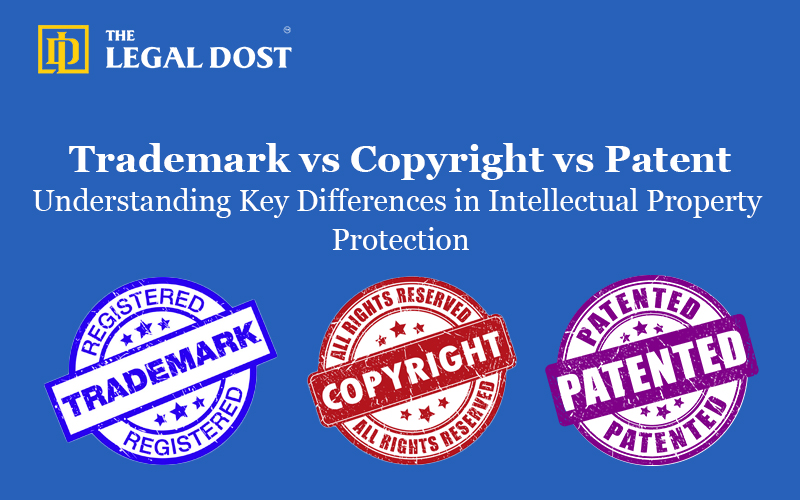Trademark vs Copyright vs Patent: Understanding Key Differences in Intellectual Property Protection
 Rahul Gupta
Rahul Gupta
Protecting intellectual property (IP) is crucial for companies and creators in the competitive world of today. However, it's easy to become confused about the unique meanings and functions of terminology like trademark, copyright, and patent because they are often used interchangeably. This blog will explain the difference between copyright and trademark in terms of its application in intellectual property rights (IPR), legal protections, and purposes. Understanding these concepts will help you protect your inventions, brands, and creativity.
What is a Trademark?
Trademark Meaning: A trademark is a unique word, phrase, design, or logo that makes a product or service stand out from others on the market. Common trademark examples include well-known logos and brand names. Yet, what does a trademark protect? Basically, a trademark protects the identity of a business and makes it easy for customers to recognize what a company sells.
Importance of Trademarks: When it comes to building brand loyalty and reputation, trademarks are very important. They keep other people in the market from misusing or misrepresenting a brand, so customers can trust where the goods or services they buy come from.
Trademarks in IPR: Trademarks are a type of intellectual property rights (IPR). They protect brands legally by preventing other companies from using similar designs or symbols that could confuse customers. The effect of a trademark registration is important because it gives the owner exclusive rights and lets them sue anyone who uses the trademark without permission.
Trademark Symbol Copy: The ® symbol shows a registered trademark, while the ™ symbol shows an unregistered trademark. Both of these symbols let people know that someone owns that mark, which strengthens trademark protection.
What is Copyright?
Copyright is another way to protect your intellectual property, but it's not the same as a trademark. Copyright protects original works of writing, while trademarks protect things that identify a brand. Copyrighted content includes things like music, movies, books, as well as artwork.
Copyright in IPR: Copyright gives the people who made the work the only right to copy, share, perform, and show it. Copyright generally has a time limit—usually the creator's lifetime plus an extra number of years. Trademarks, on the other hand, are permanent as long as they are in use.
Difference Between Trademark, Copyright and Patent
The following table will define the difference between trademark, copyright, and patent:
| Feature | Trademark | Copyright | Patent |
| Objective | It safeguards brand identity and prevents consumer misunderstanding. | It safeguards unique artistic creations from unapproved usage or reproduction. | Safeguards functional designs, procedures, or inventions. |
| What It Covers | Symbols, slogans, brand names, logos, and other identifiers. | Works of literature, art, music, software, movies, and architecture. | Inventions that are new and useful, such as products, processes, or machinery, are also considered. |
| Protection Scope | It distinguishes one entity's products or services from another. | Not the ideas themselves, but the way they are expressed is protected. | It grants the creator full rights for a certain amount of time. |
| Duration | As long as you utilize it for business purposes and renew it on a periodic basis, you can keep it permanently. | The lifespan of the author extends to 60-70 years, depending on the specific jurisdiction. | It typically enters the public domain 20 years after the filing date. |
| Symbol | ™ (for unregistered) or ® (for registered trademarks) | © | There is no specific symbol, but people frequently use patent numbers for identification. |
| Legal Registration | Although not necessary, registration offers more protection. | The creation process is automatic in tangible form, but registration offers extra advantages. | It requires a proper application procedure and patent office approval. |
| Enforcement | When unauthorized commercial use or imitation occurs, one can file a lawsuit for infringement. | You have the right to take legal action against any unauthorized reproduction, distribution, or adaptation. | It has the power to stop others from producing, utilizing, or commercializing the patented innovation without authorization. |
| Relevant Law Area | Intellectual property rights (IPR) encompass trademark law. | Copyright law under IPR. | Patent law under IPR. |
| Common Misconceptions | People often mistake them for copyrights, yet their protection is limited to brand identifiers. | Names, titles and phrases are not protected. | It solely safeguards functional or technical elements, not abstract ideas. |
| Typical Misuses | If you use names, logos, or symbols interchangeably, customers might get confused about the source. | Unauthorized distribution or duplication of another person's work. | Unauthorized creation or sale of an invention that resembles a patented product or process is prohibited. |
| Examples | Coca-Cola® name, the Nike® logo, and McDonald’s® slogan “I’m Lovin’ It.” | Books, movies, songs, software code, paintings, and architecture are all examples. | For example, the design of a smartphone, a new drug formula, or a new way to make something. |
Why is Trademark Protection Important?
In modern business, one cannot overestimate the importance of trademarks. A well-known trademark fosters brand loyalty and trust by making goods and services easier for customers to recognize.
Businesses can preserve a unique brand identity by employing trademark rights to stop rivals from using names or logos that are too similar. Additionally, trademark registration provides a further layer of security and allows legal action if someone tries to imitate or abuse a brand's name, symbol, or logo.
Trademark, Copyright, and Patent: Choosing the Right IP Protection
Gaining knowledge of the difference between copyright, patent, and trademark guarantees that companies and creators may choose the best legal protection for their intellectual property. Copyright protects original authorship works; trademarks protect brand identity; and patents protect inventions.
There are different types of intellectual property, and to protect a company's assets, you need to know when to use each type. The difference between brand and trademark, for example, is that a trademark protects the logos, symbols, or phrases that reflect a brand, while a brand is how people think of a company as a whole.
Summary
In summary, understanding the trademark and copyright differences empowers artists and businesses to make informed decisions about intellectual property protection. While trademarks are vital for safeguarding a company's identification, copyright is important for creative works. Intellectual property rights trademark rules protect companies' distinctive identities and creative works, which helps them succeed in highly competitive markets.
It's beneficial for business to protect intellectual property (IP), and it also helps people be creative, think of new ideas, as well as trust your brand. These ideas will help you protect your work and build a stronger brand image, no matter if you're a new business owner or a well-known creator.
Subscribe to my newsletter
Read articles from Rahul Gupta directly inside your inbox. Subscribe to the newsletter, and don't miss out.
Written by
